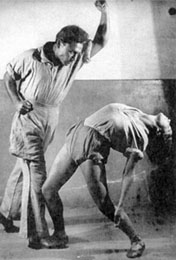Karl Kasimir Theodor Meyerhold (1874 - 1940)
Meyerhold (Karl Kasimir Theodor Meyerhold) 1874 - 1940
Karl Kasimir Theodor Meyerhold was a Russian and Soviet theatre director, actor and theatrical producer whose provocative experiments dealing with physical being and symbolism in an unconventional theatre setting made him one of the seminal forces in modern theatre.
Meyerhold participated in a number of theatrical projects, as both a director and actor. Each of his projects served as an arena for experiment and creation of new staging methods.
Meyerhold was one of the most fervent advocates of symbolism in theatre and tried to returnacting to the traditions of Commedia dell'arte rethinking them for contemporary theatrical reality.
There are close links between Meyerhold and Stanislavski (see the Stanislavski link for more information)
Where Stanislavski's Method Acting melded the character with the character with the actors own personal memories to create the characters internal motivation Meyerhold connected psychological and physiological processes and focussed on learning gestures and movements as a way of expressing emotion outwardly. In this respect his work is very similar to that of Stanislavski, Using the physical or outward display to project that of internal or psychological process.
Although Stanislavski inspired method acting, he was also at odds with it, because like Meyerhold, his approach was known as Psychophysical. Meyerhold worked with Stanislavski and even ran his theatre for a year after his death. The following year Meyerhold was captured, tortured and brutally executed.
Biomechanics is the term associated with Meyerholds technique. It is the movement of the body the breaking down of a series of movements known as 'Etudes'. Like in music the term 'Etudes' means 'a study'. When applied to biomechanics 'Etudes' literally means the 'study' of a particular movement or sequence of movements, the most famous of the these is 'shooting from the bow'.
The modern interpretation of Biomechanics may be the study or art of physical theatre.
Meyerhold participated in a number of theatrical projects, as both a director and actor. Each of his projects served as an arena for experiment and creation of new staging methods.
Meyerhold was one of the most fervent advocates of symbolism in theatre and tried to returnacting to the traditions of Commedia dell'arte rethinking them for contemporary theatrical reality.
There are close links between Meyerhold and Stanislavski (see the Stanislavski link for more information)
Where Stanislavski's Method Acting melded the character with the character with the actors own personal memories to create the characters internal motivation Meyerhold connected psychological and physiological processes and focussed on learning gestures and movements as a way of expressing emotion outwardly. In this respect his work is very similar to that of Stanislavski, Using the physical or outward display to project that of internal or psychological process.
Although Stanislavski inspired method acting, he was also at odds with it, because like Meyerhold, his approach was known as Psychophysical. Meyerhold worked with Stanislavski and even ran his theatre for a year after his death. The following year Meyerhold was captured, tortured and brutally executed.
Biomechanics is the term associated with Meyerholds technique. It is the movement of the body the breaking down of a series of movements known as 'Etudes'. Like in music the term 'Etudes' means 'a study'. When applied to biomechanics 'Etudes' literally means the 'study' of a particular movement or sequence of movements, the most famous of the these is 'shooting from the bow'.
The modern interpretation of Biomechanics may be the study or art of physical theatre.
'tripping up'
COMMEDIA DELL'ARTE
Commedia dell'Arte, also known as "Italian comedy," was a humorous theatrical presentation performed by professional players who travelled in troupes throughout Italy in the 16th century. Performances took place on temporary stages, mostly on city streets, but occasionally even in court venues. The better troupes—notably Gelosi, Confidenti, and Fedeli—performed in palaces and became internationally famous once they travelled abroad. Music, dance, witty dialogue, and all kinds of chicanery contributed to the comic effects. Subsequently the art form spread throughout Europe, with many of its elements persisting into present-day theatre.
For more information follow the below link.
http://www.theatrehistory.com/italian/commedia_dell_arte_001.html
BIOMECHANICS
Meyerhold:
An actor must possess the capacity for Reflex Excitability. Nobody can become an actor without it… From a sequence of physical positions and situations there arise points of excitation which are informed with some physical emotion. Biomechanics establishes the principles of precise analytical execution of each motion, establishes the differentiation of each motion for purposes of maximum precision, demonstrativeness -- visual Taylorism of motion (Sign of refusal -- the establishing of the start and end points of motion, a pause after each accomplished motion, the geometrization of movement in planes.) We must be able to show the modern actor on stage as a complete automation. The actor's art is the creation of plastic forms in space. Therefore, the actor's art is the ability to utilize the expressive potential of his body correctly. This means that the route to image and feeling must begin not with experience, not with seeking to plumb the meaning of the role, not with an attempt to assimilate the psychological essence of the phenomenon, in sum, not "from within" but from without; it must begin with motion. This means the motion of an actor excellently trained, possessing musical rhythm and easy, reflectory excitability; an actor whose natural abilities have been developed by systematic training. BioMechanics.
http://loosavor.org/2006/08/biomechanics_social_engineerin.html
The above document contains alsot of information regarding Meyerhold and Biomechanics.
It also features important information about the economical and political influence.
Subscribe to:
Posts (Atom)

